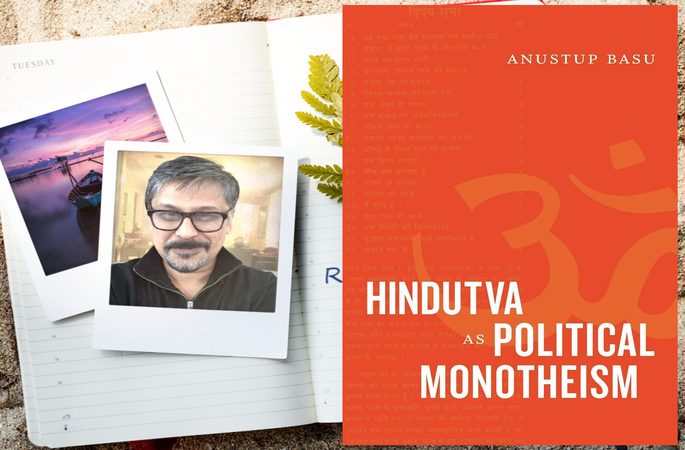Anustub Basu’s book Hindutva as Political Monotheism in several ways chronicles the pantheistic strands within Hinduism and traces the genealogy of Hindutva as political monotheism while decoding its political DNA. He opens with Kancha Illaiah’s sudra critique of Hindu philosophy, culture and political economy while addressing Hindu identity questions.
Basu lays out the pitfalls of the globalisation of the Indian economy, the rapid expansion of the electronic public sphere and accelerated urbanisation leading to the demolition of Babri and riots thereafter, border war with Pakistan in 1999, increasing unrest in Kashmir, to culminating in the 2002 genocide of Muslims in Gujarat.
The world theatre of fascism, liberal crisis and rise of chauvinisms is also aided by various revivalisms like Jair Bolsanaro’s monarchism, Recep Tayyip Erdogan’s neo-ottomanism, Jacksonist ‘know nothing’ nativism in Trump’s the USA and the long genesis of Hindu political identity in India. Basu’s meticulous chronology, which is not necessarily linear and insightful analysis, uses the framework of Nazi jurist Carl Schmitt. Schmitt’s work on ethnocentric nationhood had a political monotheistic imperative.
He traces contemporary Hindutva’s political theology, which compacts a pantheon of 330 million gods into axiomatic Hindu icons of Ram and Krishna, leading to a monotheistic political Hindutva indistinguishable from an ‘Indian one’. He lays out contradictions within this Hindutva project, a general puritanical desire of a majoritarian unity and reducing choices. It becomes a mutual arrangement between modernity and tradition rather than a conflict.
In his first chapter – Questions of Hindu Political, Basu sets the tone of his argument by recounting the political economy of Thatcher –Reagan neoliberalism followed by Clintonism and Blairite labour, the 2008 crash, renewed cultural and ideological wars as well as religious and ethnocentric assertions. He brings forth Schmitt’s political monotheism that favours primordial piety, thereby trivialising collective binding principles of sentiment, memory, language, constructivism and catastrophe.
Further scrutinizing the outlandish project of Schmitt’s monotreme of identity, he lays bare the vastness of rich polytheistic heterogeneity of multi-religious India and multiplicity of faiths within Hinduism. Further consolidating Hindutva project as Eurocentric Schmittian model that denies any apostates, pagans or heretics any legitimacy within this political model.
Basu invoking the memories of concentration camps ties the larger right-wing fascist agenda across continents while listing Trump’s detention camps for Latino immigrants in the USA, Brexit, Europe’s anti-immigrant movements and the National Register of Citizens in India.
In Basu’s words, the Schimittian framework doesn’t discard democracy but relegates parliamentarism and encourages representational pieties of democratic republics. One of the major contentions of liberals and left liberals in India has been with the term fascism and the question of whether it can be used to define contemporary India or Hindu nationalism.
While elaborating on European fascists and Nazi cults, Basu specifies that exact parallels are difficult to find especially when one tries to make direct comparisons between capitalists, petit-bourgeois and landlord classes of Europe and India, however refraining from absolutist temptations, he elaborates on how fascism works in conjunction with indigenous models in deeply hierarchical societies in feudal traditions.
In the following chapter, the historicity of authoritarianism and admiration for Hitler and Mussolini as strong fathers created an unofficial acceptance of these dictators are discussed.
Apart from hard Hindutva, Gandhi’s ambivalence towards Mussolini and Subhash Chandra Bose’s ambitions of an Indian version of fascism and socialism paved the way to the Indian state’s heavy militarisation in the later years. Citing the tensions within Indian democracy, Basu elaborates on 1950s Nehruvianism as it took a bureaucratic form. The design of constitutional state and the separation of powers clearly threatened the liberal upper caste leaders, raising the fear of majoritarian upheaval against its own democratic political system.
In India, the abolition of the constitution still remains the Sangh Parivar’s (the consolidated right-wing family) agenda. Expanding on a common historical background and stressing upon the well-known institutional affinities between Hindutva and European style fascism, Savarkar’s speeches glorifying German Nazism and Italian fascism, Golwalkar’s efforts to distinguish pure nationhood and Moonje’s visits to Mussolini’s Italy that resulted in the establishment of Bhosala Military School, in Nasik, India, inspired by martial order youth organisations like Batilla and Avanguardisti, he clears all doubts around the fascistic foundations of Hindutva. However, he states that this was not one-way traffic in terms of ideology, mythology and power.
German and European philosophers’ bents towards Indology, occult and Aryan supremacist theories remained the topics of interest for thinkers like Nietzsche and later inspired figures like Heinrich Himmler. Hindutva mobilisation doesn’t just borrow select features like orientalist vision and Aryan supremacy, but the very concept of idealising a nation was extracted from the west.
Basu also examines the concept of people /volk in Kautilya’s Arthshastra and German tradition of organismic thinking, thereby bringing in the essence of Golwalkar and Deen Dayal Upadhyay’s adherence to organismic lines, albeit with a cosmic bent. The confusion over the framework within Hindutva ideologues has been put forth meticulously. He assesses the works of Bimal Krishna Matilal, an Indian philosopher dismantling the modernist desire of casting Hinduism in Abrahamic mould. He painstakingly lists out the classical systems of Indian philosophy and rich tapestry of faiths, materialism and atheism.
The literary project of Hindutva’s genesis starts with the Bengal renaissance and the obvious influence of Indology. He traces various writing of nationalist, right-wing ideologues and pompous claims of P.N Oak, where he lays Hindu stakes on Taj Mahal, Qutub Minar or even Kabah in Mecca.
One of the crucial aspects foregrounding the dynastic lineage of Hindu texts and clarifying the philological methods, Basu shows how Hindutva refutes Aryan invasion theory to solidify the origins of the Hindu nation and people. However, Aryan theory isn’t the final instance here determined by natural boundaries. Still, he states that the spiritual geography of the nativity, work, and salvation renders an amorphous and mobile figuration capable of extending territorial claims within and outside the sub-continent.
Hindutva fantasy of Akhand Bharat has imperialist ambitions of territorial expansion similar to the Nazi Lebensraum. In this neo-Brahminical masculinist display of Hindutva, Mahatma Gandhi’s postulations, where he presented Ram as an androgynous god with righteousness and self-sacrificing traits, he became an obstinate challenge to Sangh Parivar.
In the third chapter, The Indian Monotheism, the origins of modern Hinduism are explored through epistemological perspective and the project of modernity. The literary project of assigning a holy book to Hinduism akin to Abrahamic faiths is achieved with the first translations of Gita and the advent of print capitalism in the Indian sub-continent.
Referring to Sibaji Bandyopadhyay’s expansive study of the textual career of Gita and more than three hundred translations in English, works of Indian nationalism architects like Bankimchandra Chattopadhyay, Bal Gangadhar Tilak, Swami Vivekanand, Sri Aurbindo, Rajagopalachari and unsurpassed Gandhi do not mention any internal battle of Hinduism, whether Gita as a holy book should gain prominence over Vedas. Later reform movements within Hinduism like Arya Samaj further establish a monotheistic faith over rituals and superstitions.
Basu elaborates on the politics of India’s early census, diversity issues, and caste question while decoding the Hindu identity. He emphasises on Bankim Chandra’s literary career marked by the advent of print capitalisms in the vernacular languages culminating in the landmark romance Anandmath published in 1882, which sowed the seeds of martial and spiritual discipline.
The chapter’s concluding note brings in the refreshing and nuanced critique of Hinduism by Dr B R Ambedkar. This line of interrogation through Ambedkar’s writings the unfortunate precedence given by upper-caste nationalists to a political revolution as opposed to a social one brings forth the inherent flaws of Indian democracy and political life.
Chapter 4 is the final and conclusive account of the Hindutva project. Basu brings us to contemporary Hindutva after extensively and laboriously accounting for all the factors, theological questions and formulations. His detailed theoretical account established Carl Schmitt’s political monotheism that helps a reader develop a thorough understanding of Hindu monotheism that has Abrahamic inspiration. In this final chapter, he moves from print capitalism to electronic media.
While extrapolating this journey, he further expounds on the establishment of Gita Press, a publication that helped in the growth of this monotheistic political faith and developed a profiteering model of publication through piety. Gita Press’s publications aided the Hindu colonisation of tribals in India. It lay claims over Dalits, Jains, Buddhists and Sikhism, thereby completing the project Hindi Hinduness and Hindustan on the Schmittian concept of nationhood.
Basu explains the advent of the information age and the phenomenal rise of Hindutva thereon. From the language colonisation of post-independence Hindutva ideologues, he proposes that new syntactic use of Hinglish and mediums like VHS tapes and audiocassettes quickened the process of masculinised Hindu identity.
Basu notes that Hannah Arendt’s models of fascism and Nazism share alarming proximity with Hindu nationalism. He follows Arendt’s analysis of features of totalitarianism like gangsterism and para-militarism involving activist groups like Gau Rakshaks responsible for beef lynching in India and the “party above all parties” model.
Combining a Hindu sense of being and a neoliberal credo of development, he elaborates on Modi’s rising as a leader in the digital age. He interestingly classifies three archetypical voters of Modi, who helped him win the general elections in 2014.
His insightful observations on the digital age in Bollywood and science fantasies combined with Vedic and puranic cosmologies into the generic superhero films that infuse energies of patriotism and creation of a golden past are potent and on point. Bollywood as a soft power is not just the Hindutava phenomenon, from Nehruvian socialism to 1970s disillusionment of democracy; Hindi film industry has played a decisive role in generating consensus.
The phenomenal work on Hindutva’s genesis concludes with mapping the contemporary sociology of Hindutva and what is at stake for people who do not fit into this political monotheistic matrix of piety. The seismograph of the collective sub-consciousness of willingness to be violently supportive of the Hindutva regime has been the norm since 2014. Those of us who have been unable to be hypnotised are the ones who will have to endure the pain caused by this violent political prescription.
Anustup Basu’s work will remain a necessary topical intervention while addressing the genesis of Hindu fascism and the political monotheistic fascination of its ideologues. He foregrounds its implication not just to Narendra Modi’s emergence as a powerful, authoritative leader with his anti-Muslim policies but also to mainstream Indian nationalism and secularism post-independence.



